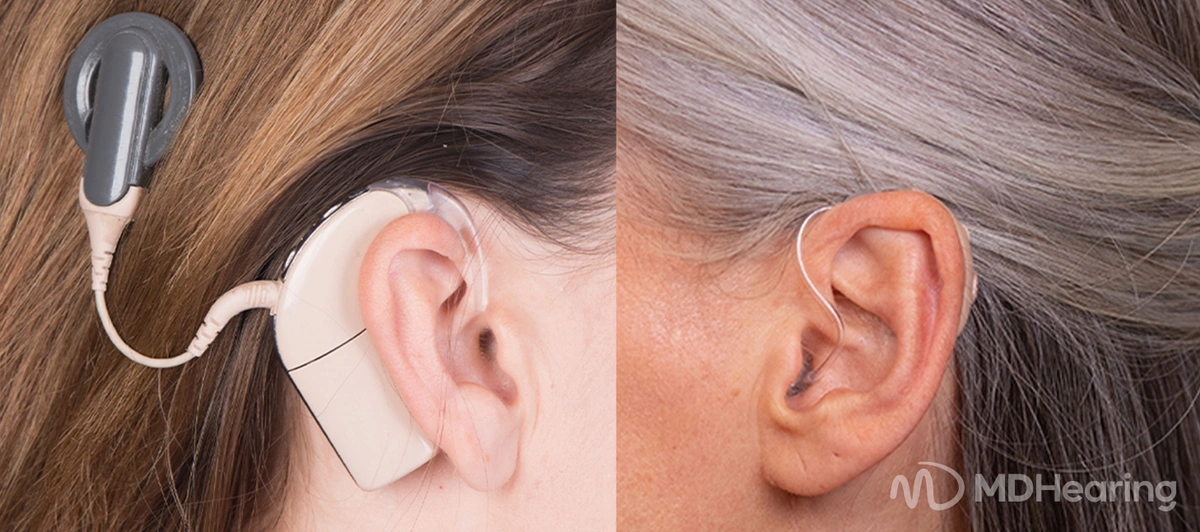Hearing loss impacts about 30 million people in the U.S. While many could benefit from hearing devices, only 1 in 4 hearing loss patients has used hearing aids. That number drops significantly to just 6% when referring to Americans that have used cochlear implants.
According to the National Institute on Deafness and Other Communication Disorders, since 2019, it’s estimated that more than 736,000 cochlear implants have been implanted worldwide. About 118,000 were implanted in adults and 65,000 in children in the United States alone. Cochlear implants have been researched since 1950 and used as FDA-approved medical devices since the 1980s.
If you or a loved one has a hearing loss, you may wonder if a cochlear implant can help. Many cochlear implants look like hearing aids—but they’re not the same—so it’s important to understand the differences.
In this article, you’ll learn everything you need to know about a cochlear implant, how it works, and who’s eligible to get one. In addition, we’ll talk about some of the pros and cons of cochlear implants as well as uncover if they’re better than hearing aids.
What is a Cochlear Implant?
A cochlear implant is a small electronic hearing device that’s surgically placed in the ear and designed to stimulate the nerves in the inner ear. It provides hearing sensations for a person severely or profoundly hard of hearing.
The cochlear implant is made of two main parts: one internal and one external. The internal part is surgically implanted underneath the skin. It has an electrode that sits inside the cochlea. The external part sits on the outside of your head behind the ear (some types look like a hearing aid). A magnet connects the two parts, and the external earpiece can be removed when not in use.
How Does a Cochlear Implant Work?
Technically, cochlear implants don’t help restore normal hearing, as is the case with hearing aids that amplify sound. Rather, a cochlear implant provides an imitation of sound that allows recipients to understand human speech and make sense of other sounds.
Each part of a cochlear implant serves a specific and essential purpose.
- Microphone – picks up sounds in the environment
- Speech Processor – organizes sounds from the microphone
- Transmitter and Receiver/Stimulator – converts sounds into electric impulses
- Electrode Array – collects and sends the electric impulses to the auditory nerve
The electrode array lines the cochlea and acts as a replacement for the damaged nerve cells or sensory hairs on the ear. These electrodes can pick up a range of high-frequency and low-frequency sounds that are processed and converted after passing through the microphone. When the electric impulses are sent to the auditory nerve, the brain interprets them as sound.
What Does a Cochlear Implant Sound Like?
A person who gets a cochlear implant doesn’t have their natural hearing restored. Instead, the medical hearing device provides an artificial representation of sound. That means when a new cochlear implant is turned on for the first time, you likely won’t recognize the sounds as being the same as those you’re used to hearing.
Initially, a cochlear implant recipient won't be able to understand speech clearly. For example, new recipients say that human voices sound robotic or like Donald Duck; they can’t tell the difference between one person talking and another.
New users also have a hard time distinguishing between different sounds at first. For example, they may hear a faucet dripping but not be able to tell what it is, unless they happen to see it dripping and put two and two together.
This is because the brain needs to learn to hear again, which takes time. The brain starts to process sounds within the first few weeks of activation, during which an audiologist will adjust the processor. Over the next few months, the sounds become familiar, but it can take up to three to six months to understand speech more comfortably.
Those who have the most success with cochlear implants are adults with a history of being able to hear and speak. Adults who have been deaf or severely hard of hearing since they were young will have missed the critical period for developing speech and language skills. That’s why it’s vital for children to use a cochlear implant as early as possible.
How Cochlear Implants Differ From Hearing Aids
Some cochlear implants look just like hearing aids, but there are noticeable differences between the two.
Device Design
Cochlear implants use external parts that sit on the skull near the ear or hook behind the ear like a standard hearing aid. Magnetic pieces attach the processor to the internal electrode. No parts of a cochlear implant processor go into your ear canal, unlike a hearing aid where a piece MUST go into the ear canal in order to hear.
Hearing aids, on the other hand, come in a wider range of shapes and sizes that can fit behind the ear or in the ear. Other than the tip you insert in the ear canal, there are no internal pieces of a hearing aid.
Sound Processing
Cochlear implants receive sound from a microphone, convert the sound into radio frequency, and send it into the implant to be converted to electrical impulses. The impulses are then sent to the cochlea, where the auditory nerve picks them up.
Hearing aids also process sound from a microphone, but that sound is amplified in the hearing aid and then sent to the ear canal via the receiver.
Some models of cochlear implants and hearing aids can be programmed to have different settings for various listening environments. Depending on the device, these can be changed by pushing buttons on the processor or making changes using a remote or app. Some devices can automatically adjust the setting as the environmental sounds change.
Procedure and Risks
The standard cochlear implant requires outpatient surgery. Patients are typically put to sleep under general anesthesia. The surgeon goes through the skull behind the ear and places a tiny strip of electrodes into the cochlea while a magnet attached to the electrodes is placed under the skin’s surface. After the surgical site heals (about four to six weeks), the external processor is connected, activated, and programmed. As with all surgery, there are risks, but the process is safe and complications are rare.
Because hearing aids only require an external device, they do not involve the recovery and risks associated with cochlear implant surgery. They can be easily fitted and programmed in a hearing clinic, as well as through an online hearing aid provider.
Medical Care
Cochlear implants require seeing an otolaryngologist, a physician also known as an ENT (ear, nose, and throat). Usually, you’ll see a medical doctor with specialized training in cochlear implant surgery. After the surgery has been completed, you’ll be seen by an audiologist to program the external device.
Hearing aids typically require hearing tests and other evaluations to diagnose a hearing loss. Some people go to an ENT first, who would then send them to their associated audiologist for hearing tests and hearing aid fittings.
Eligibility
Cochlear implants are only available for people with severe or profound sensorineural hearing loss in at least one ear. They must undergo a series of hearing and physical evaluations. In addition, they may be required to try hearing aids before approval. The process can take several months. In most cases, if you’re a candidate for a cochlear implant in a particular ear, you’re no longer a candidate for a hearing aid in that ear.
Conversely, you can get hearing aids without seeing a medical doctor or obtaining a prescription. In fact, new legislation recently made it possible for adults with hearing loss to buy over-the-counter hearing aids. However, it’s always recommended to consult with a physician or audiologist to ensure there aren’t any underlying issues that may be causing hearing loss.
Costs
Cochlear implants are costly due to the expenses associated with everything from the multiple exams (e.g., MRI and CT scans) and surgical implant procedures to the medical device’s advanced technology and follow-up medical appointments. The average cost for a single cochlear implant varies from $20,000 to $40,000, although health insurance often pays for a large portion of it.
Hearing aids are much more affordable and range in price from a few hundred to several thousand dollars, depending on where you purchase them from. Health benefits vary by state, but few plans offer hearing aid coverage.
FDA Approval
Cochlear implants are medical devices approved by the Food and Drug Administration (FDA) for use on adults since the mid-1980s and on children 12 months and older since 2000. FDA-approved implants can be used to treat people with hearing loss but must be done under the care and guidance of a medical doctor.
The FDA has yet to approve hearing aids. However, it does provide FDA-registration to some hearing aid manufacturers and models. This means the hearing aids are registered with the FDA as low-risk medical devices. Recent legislation has also approved selling hearing aids over the counter (OTC) without a prescription.
On the outside, most cochlear implants look like hearing aids. And both help people with hearing loss to have a better quality of life. However, they differ significantly when it comes to the way they're made and how they process sound. Also, while cochlear implants have received FDA approval, they come at a much greater cost and risk due to the need for surgery.
Have Your Hearing Tested
Whether you’re a potential candidate for cochlear implants or hearing aids, it’s crucial to have your hearing checked. Any signs of hearing loss must be evaluated to rule out underlying medical conditions and prevent a potential issue from worsening. In addition, untreated hearing loss can lead to stress, social isolation, depression, loneliness, cognitive decline, and more.
At MDHearing, we understand the importance of maintaining good hearing health. We offer FDA-registered hearing aids at affordable prices. Our team of licensed audiologists and hearing specialists is here to answer any questions you may have, so don’t hesitate to contact us.
If you think you might have hearing loss, take our free online hearing test today!
Want to find out if you have hearing loss? Take our quick and easy online hearing test.
TAKE THE FREE HEARING TEST

